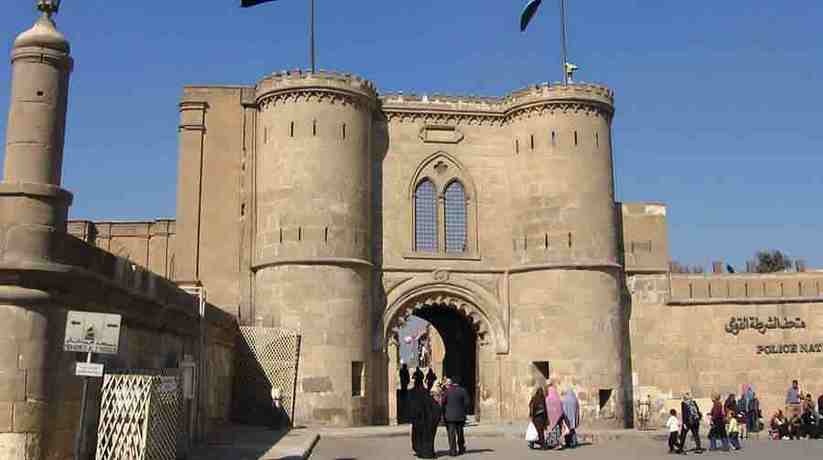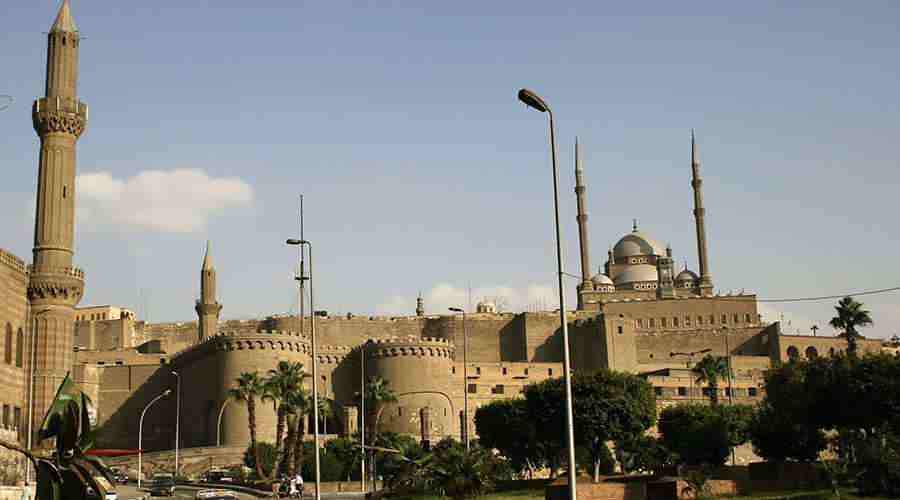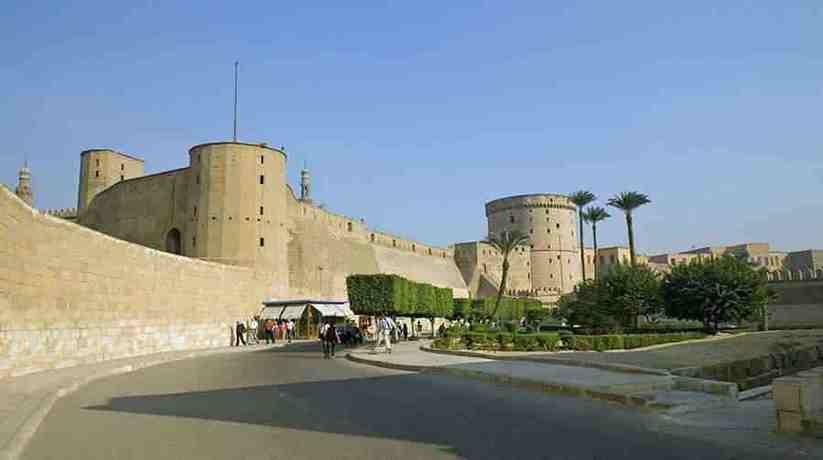Cairo Citadel Egypt tours, booking, prices, reviews
Cairo Citadel indeed is one of Cairo’s most popular tourist attractions. It located on a spur of limestone that detached from its parent Moqattam Hills by quarrying. Moreover, Cairo Citadel is one of the world’s greatest monuments to medieval warfare. In fact, it is a visible landmark on Cairo’s eastern skyline. When viewed from the back side, Cairo Citadel reveals a medieval character. The area where Cairo Citadel located now began it’s life as the “Dome of the Wind”. It is a pavilion which created in 810 by Hatim Ibn Hartama, who was then governor. Indeed this area well known for its cool breeze. In fact, the early governors didn’t realize its strategic importance. However, they used the pavilion for its view of Cairo.
During 1176 and 1183 Salah El Din fortified the area to protect Cairo from Crusaders attacks. Since then, it never been without a military garrison. In fact, it served as both a fortress and a royal city. Legend has it that Salah El Din chose the site for its healthy air. The story goes that he hung pieces of meat up all around Cairo. Everywhere in Cairo the meat spoiled within a day. At Cairo Citadel area, it remained fresh for several days. This location provides a strategic advantage to dominate Cairo and to defend outside attackers. Salah El Din came from Syria. It is where each town had some sort of fortress to act as a stronghold for the local ruler. It was natural that he would carry this custom to Egypt.
Further details about Cairo Citadel:
Moreover, Salah El Din used the most modern fortress building techniques to construct Cairo Citadel. Great, round towers built protruding from the walls. The defenders could direct flank fire on those who might scale the walls. In fact, the walls themselves were ten meters (30 ft) high and three meters (10 ft) thick. The Bir Yusuf (Salah El Din’s Well) dug to supply the occupants of the fortress with drinking water. Some 87 meters (285 ft) deep, it cut though solid rock down to the water table. It is not a shaft. There is a ramp large enough. Animals could descend into the well to power the machinery which lifts the water. The well closed to tourists these days.
After the death of Salah al-Din, his nephew, Al Kamel, reinforced the Cairo Citadel. It was by enlarging several of the towers. He encased the Burg al-Haddad (Blacksmith’s Tower) and the Burgar Ramla (Sand Tower). Moreover, he made them three times larger. These two towers controlled the narrow pass between Cairo Citadel and the Muqattam hills. Al Kamel also built some great keeps (towers) around the perimeter of the walls. Three of them can still seen overlooking Cairo Citadel parking area. These massive structures were square, up to 25 meters (80 ft) tall and 30 meters (100 ft) wide. In 1218, upon the death of Al Kamel’s father, Sultan Al Kamel moved his house to Cairo Citadel. It is where he built his palace in what is now the Southern Enclosure.
More details about Saladin Citadel Cairo:
In fact, the palace no longer exits. It was the seat of government for the Country of Egypt until the construction of the Abdeen Palace. Mumluks overthrew the Ayyubid rulers in 1250. Their sultan Baybars Al Bunduqdari (1260-77) moved into Al Kamel’s palace. Moreover, he isolated the palace compound by building a wall. It divided the fortress into two separate enclosures. They linked by the Bab (gate) Al Qullah. The area where the palace once stood referred to as the Southern Enclosure. The larger part of Cairo Citadel proper referred to the Northern Enclosure. Al Nasser Muhammad interested with this era. In fact, he ruled during three separate periods (1294-1295, 1299-1309 and 1310-1341). Moreover, he tore down most of the earlier buildings in the Southern Enclosure. He replaced them with grander structures.
Unfortunately, the only remaining facility built by him is the Al Nasser Mohammad Mosque. In fact, it begun in 1318, finished in 1355 and located near the enclosure gate. He built a great Hall of Justice with a grand and green dome. It towered above the other structures in the Southern Enclosure. Beside it built the Qasr Al Ablaq (Striped Palace) with its black and yellow marble. This palace, used for official ceremonies and conducting affairs of state. Moreover, it had a staircase leading down to the Lower Enclosure and the Royal Stables. It is where An-Nasir kept 4,800 horses. The Ottomans controlled Egypt between 1517 and the early 20th century. Much of what we see of Cairo Citadel actually dates back to this period.
Further details about Salah El Din Citadel Cairo:
The Lower Enclosure where the stables of Al Nasser known as Al Azeb. It was because some of the Ottoman soldiers, known as the Aazab regiments. These soldiers not allowed to wed until they retired. The word Aazab means bachelor. The Ottomans rebuilt the wall which separates the Northern and Southern Enclosures. It was as well as the Bab Al Quallah. Moreover, they also built the largest tower in today’s Citadel. It is Burg Al Muqattam which rises above the entrance to Cairo Citadel off Salah Salem Highway. In fact, this tower is 25 meters (80 ft) tall and has a diameter of 24 meters (79 ft). In 1754 the Ottomans rebuilt the walls of the Lower Enclosure. He also added a fortified gate called the Bab El Azab.
On the late 16th century, the strict military structure for the Ottoman soldiers deteriorated. During this period, the Aazab troops began to marry. They even allowed to build their own houses within the fortress. By the mid 17th century, Cairo Citadel became an enclosed residential district. Moreover, it became with private shops and other commercial enterprises. It was besides to public baths and a maze of small streets. The Ottoman Mohammad Ali Pasha came to power in 1805. He was indeed one of the great builders of Modern Egypt. Moreover, he was responsible for considerable alteration and building within Cairo Citadel. He rebuilt much of the outer walls and replaced many of the decaying interior buildings. Furthermore, he also reversed the roles of the Northern and Southern Enclosures.
More details about Cairo Citadel:
Moreover, he made the Northern Enclosure his private domain. The Southern Enclosure opened to the public. Mohammad Ali Mosque built in the style called Ottoman Baroque. In fact, it imitates the great religious mosques of Istanbul, today dominates the Southern Enclosure. South of the Mosque in the Hawsh is the Gawhara Palace. Gawhara means jewel. This structure built between 1811 and 1814. Moreover, it housed the Egyptian government until it later moved to the Abdeen Palace. Today there is also the National Police Museum at Cairo Citadel. It built over the site of the Mamluk Striped Palace just opposite the Mosque of Al Nasir Muhammad. Moreover, it has displays of law enforcement dating back to the dynastic period.
In 1983 a hall from the Striped Palace discovered. It buried deep beneath rubble, and can be seen at the southern end of this terrace. The terrace also provides a wonderful view of Cairo. Through Bab Al Qullah in the Northern Enclosure one finds Mohammad Ali’s Harim Palace. The palace built in the same Ottoman style as the Jewel Palace. The statue in front is of Ibrahim Pasha by Charles Cordier. The Palace served as a Family house for the Khedive. It was until the government moved to Abdeen Palace. Moreover, it was a military hospital during the British occupation. It only returned to Egyptian control after World War II. Since 1949, it is the Military Museum of Egypt In fact, it founded by King Farouk. The Museum has many artifacts illustrating warfare in Egypt.
Further details about Cairo Citadel:
One of the most interesting attractions is indeed the Summer Room. This room contains an elaborate system of marble fountains and basins. It also has channels meant as a cooling system, and is the last such example in Cairo. In the livery court behind the carriage gate of the museum, there is a statue of Sulayman Pasha. The satatue stood in the city center. Just beyond this museum is a small Carriage Museum in what was the British Officer’s mess until 1946. Just behind this museum is the Burg Al Turfah (Masterpiece Tower).
Burg Al Turfah is one of the largest square towers. It built by Al Kamel in 1207. Near the far end of the Northern Enclosure is the Sulayman Pasha Mosque. The mosque was the first Ottoman style mosque built in Egypt and dates back to 1528. In fact, it built to serve the early Ottoman troops. Today Cairo Citadel is one of Egypt main attractions. It is often the most popular non-pharaonic monuments. One may walk through time here, from the medieval era onward. Many other wonderful Islamic structures are nearby. A walk from Cairo Citadel to Khan El Khalili is indeed a delightful experiences.
















